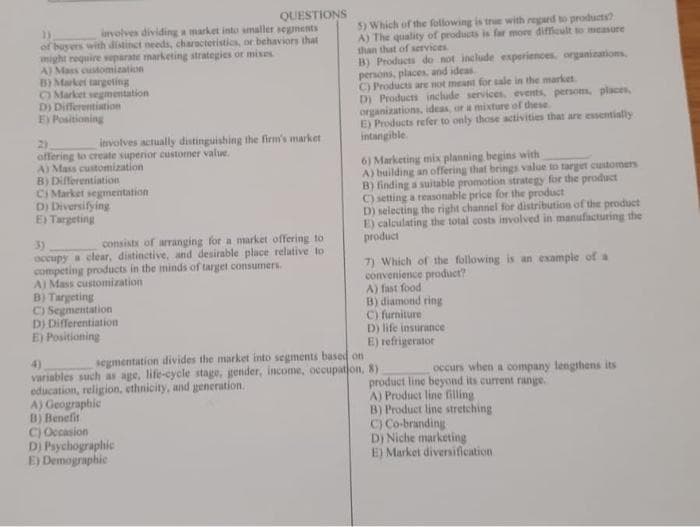of buyers with distinct needs, cha might require separate marketing strategies or mixes A) Mass customization B) Market targeting Market segmentation D) Differentiation E) Positioning involves actually distinguishing the firm's market offering to create superior customer value. A) Mass customization B) Differentiation C) Market segmentation D) Diversifying E) Targeting consists of arranging for a market offering to occupy a clear, distinctive, and desirable place relative to competing products in the minds of target consumers. A) Mass customization B) Targeting C) Segmentation D) Differentiation E) Positioning
of buyers with distinct needs, cha might require separate marketing strategies or mixes A) Mass customization B) Market targeting Market segmentation D) Differentiation E) Positioning involves actually distinguishing the firm's market offering to create superior customer value. A) Mass customization B) Differentiation C) Market segmentation D) Diversifying E) Targeting consists of arranging for a market offering to occupy a clear, distinctive, and desirable place relative to competing products in the minds of target consumers. A) Mass customization B) Targeting C) Segmentation D) Differentiation E) Positioning
Managerial Economics: A Problem Solving Approach
5th Edition
ISBN:9781337106665
Author:Luke M. Froeb, Brian T. McCann, Michael R. Ward, Mike Shor
Publisher:Luke M. Froeb, Brian T. McCann, Michael R. Ward, Mike Shor
Chapter23: Managing Vertical Relationships
Section: Chapter Questions
Problem 1MC
Related questions
Question
J 7

Transcribed Image Text:1)
QUESTIONS
involves dividing a market into smaller segments
of buyers with distinct needs, characteristics, or behaviors that
might require separate marketing strategies or mixes
A) Mass customization
B) Market targeting
Market segmentation
D) Differentiation
E) Positioning
involves actually distinguishing the firm's market
offering to create superior customer value.
A) Mass customization
B) Differentiation
Ci Market segmentation
D) Diversifying
E) Targeting
3)
consists of arranging for a market offering to
occupy a clear, distinctive, and desirable place relative to
competing products in the minds of target consumers.
A) Mass customization
B) Targeting
C) Segmentation
D) Differentiation
E) Positioning
4)
segmentation divides the market into segments based on
variables such as age, life-cycle stage, gender, income, occupation, 8)
education, religion, ethnicity, and generation.
A) Geographic
B) Benefit
C) Occasion
D) Psychographic
E) Demographic
5) Which of the following is true with regard to products?
A) The quality of products is far more difficult to measure
than that of services
B) Products do not include experiences, organizations,
persons, places, and ideas
C) Products are not meant for sale in the market.
D) Products include services, events, person, places,
organizations, ideas, or a mixture of these
E) Products refer to only those activities that are essentially
intangible
6) Marketing mix planning begins with
A) building an offering that brings value to target customers
B) finding a suitable promotion strategy for the product
C) setting a reasonable price for the product
D) selecting the right channel for distribution of the product
E) calculating the total costs involved in manufacturing the
product
7) Which of the following is an example of a
convenience product?
A) fast food
B) diamond ring
C) furniture
D) life insurance
E) refrigerator
occurs when a company lengthens its
product line beyond its current range.
A) Product line filling
B) Product line stretching
C) Co-branding
D) Niche marketing
E) Market diversification
Expert Solution
This question has been solved!
Explore an expertly crafted, step-by-step solution for a thorough understanding of key concepts.
This is a popular solution!
Trending now
This is a popular solution!
Step by step
Solved in 2 steps

Knowledge Booster
Learn more about
Need a deep-dive on the concept behind this application? Look no further. Learn more about this topic, economics and related others by exploring similar questions and additional content below.Recommended textbooks for you

Managerial Economics: A Problem Solving Approach
Economics
ISBN:
9781337106665
Author:
Luke M. Froeb, Brian T. McCann, Michael R. Ward, Mike Shor
Publisher:
Cengage Learning

Managerial Economics: Applications, Strategies an…
Economics
ISBN:
9781305506381
Author:
James R. McGuigan, R. Charles Moyer, Frederick H.deB. Harris
Publisher:
Cengage Learning

Economics Today and Tomorrow, Student Edition
Economics
ISBN:
9780078747663
Author:
McGraw-Hill
Publisher:
Glencoe/McGraw-Hill School Pub Co

Managerial Economics: A Problem Solving Approach
Economics
ISBN:
9781337106665
Author:
Luke M. Froeb, Brian T. McCann, Michael R. Ward, Mike Shor
Publisher:
Cengage Learning

Managerial Economics: Applications, Strategies an…
Economics
ISBN:
9781305506381
Author:
James R. McGuigan, R. Charles Moyer, Frederick H.deB. Harris
Publisher:
Cengage Learning

Economics Today and Tomorrow, Student Edition
Economics
ISBN:
9780078747663
Author:
McGraw-Hill
Publisher:
Glencoe/McGraw-Hill School Pub Co